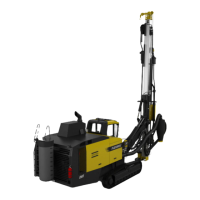SmartROC D65 Tier 4 Final 12 Compressor and air system
181
n Loading valve (solenoid valve) Y210B
n Flushing air valve Y115
n Flushing air valve Y116
When the compressor is unloaded the loading valves Y210A and Y210B are 0-activated
(open). When the compressor is loaded (button (5) on the right-hand control panel) the
solenoid valve Y210A will be activated (closed) and lead the air over the low pressure reg-
ulator (4) provided that the pressure is above 4 bar.
When low percussion is activated (S38 moved halfway forward) the low flushing air valve
(Y116) will be activated and release air to the hammer. On the low flushing air valve it is
possible to adjust the air flow to the down-the-hole drill to a moderate flow for collaring.
When high percussion is activated (S38 moved fully forward) Y210 B will also be activated
(closed). This results in the air being directed over the high-pressure regulator (3). Now the
high flushing air valve will also open (Y115) which results in full pressure and full air flow to
the hammer.
12.4.2 Setting the percussion pressure
Setting the percussion pressure is carried out by setting the tank pressure during disen-
gaged percussion.
Recommended tank pressure is 32 bar for high percussion pressure and 20 bar for low
percussion pressure
1.
Make sure the percussion is switched off.
2.
Load the compressor. (Button (5) on the right-hand control panel.)
3.
Adjust both control valves (3, 4) alternately until the recommended high percussion
pressure is obtained on pressure gauge (15).
4.
Adjust the control valve for low percussion pressure (4) until the recommended low
percussion pressure is obtained on pressure gauge (15).
!
NOTE: The adjustment must not be made during drilling.
NOTE: Percussion pressure is affected by many factors such as rock properties, size
of and wear on the down-the-hole rock drill, the drill bit, drill feed pressure, down-the-
hole rock drill air consumption etc.

